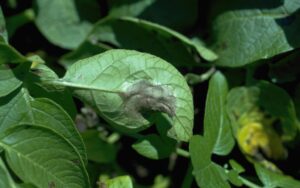Although Fig trees are tough and suited to street tree plantings in our climate, we have recently been hired to investigate the decline of several of them. Along with soil mineral depletion, the combination of events such as; many years of drought and heat waves, followed by very wet years and floods creating opportunities for nasty microbes (pathogens) to attack weakened plants and cause decline.
Usually, whenever a vascular plant, such as a tree, is experiencing stress due to one or several of these factors (nutritional, water), it will become less resilient and thereby more susceptible to disease (Anderegg et al., 2015; Camarero et al., 2015; Navarro-Cerrillo et al., 2019). Several fungi (or fungus like) and bacteria are known to be opportunistic pathogens for Figs, the famous ones being Phellinus noxious, Ganoderma, Phytophthora, Botryosphaeria. Phytophthora is one of the most important genera of pathogens causing disease and mortality of trees and forests worldwide (Barber et al, 2013). Australia’s most recent State of the Environment Report said Phytophthora cinnamomi — the soil-borne organism that causes dieback — was the second biggest introduced threat to endangered species after rabbits. A “biodiversity bulldozer“, according to ecologist Mark Garkaklis, dieback is capable of wreaking havoc on an entire ecosystem when it infects plants.
Symptoms of decline for a Fig tree can appear as: chlorotic foliage, foliage loss and sparse canopy, either from one portion or as a general canopy dieback. One very peculiar symptom can look like drilled holes in the surface roots and bark from the lower trunk, which is often misdiagnosed as; poisoning via invasive drilling or even pests famously known for similar symptoms (see borers- link here). In fact, it is neither, but a symptom caused by an oomycete (fungus-like organism) called Phytophthora.
The Phytophthora species that cause bleeding canker originate from the soil and may be causing root disease in addition to bleeding canker. They thrive in wet soils, which stimulate spore production and dispersal. Splashing rainwater spreads the spores from the soil to the lower trunk where infections establish in wounded bark, such as mechanically damaged roots. Phytophthora bleeding canker is a chronic disease that progresses very slowly within infected trees. Research has shown that overland spread of the pathogen is rare, meaning that an infected tree at a site does not pose an immediate threat to nearby trees as Phytophthora spreads naturally only by moving through soil and the roots it infects, and in run-off.
Animals spread Phytophthora when infested soil gets caught in their feet and fur and it drops off in uninfected areas. Humans spread Phytophthora when they disturb and move infested soil. Through their activities, humans have spread Phytophthora further and faster than any other means of spread.
Once a plant is infected with Phytophthora it will always be infected. It affects the water relations (hydraulic failure), mineral nutrition and general metabolism in the plant. However, management actions which increase plant health will help the plant survive and potentially even thrive. Trees infected with Phytophthora are consistently associated with wet soils, clay-panning or poor drainage. Therefore, improve drainage as much as possible; increased soil moisture favours Phytophthora development and increases dispersal of the pathogen. Factors that increase stress are likely to favour disease development, be it from high rainfall, drought, salinity or some other factor. Therefore, as much as possible, make the growing site ideal for plant growth. Unlike many other chronic diseases of landscape trees, effective treatment for Phytophthora bleeding canker is possible. Phosphite (Agri-Fos, etc.) applications have proven very effective against Phytophthora,
Maintaining a thick layer of mulch around the base of susceptible trees can also help to prevent spore germination and dispersal from the soil.
Avoid moving contaminated soil to areas with uninfected plants on equipment, vehicles and shoes. If replanting in the area, research which plants are resistant/susceptible to Phytophthora and only plant resistant species. For further information refer to the below links and other resources online.
Interested in finding out more about Phytophthora? Try some of these informative links!
http://cpsm-phytophthora.org/downloads/pubs/004.pdf
https://researchonline.jcu.edu.au/17646/1/monitoring_dieback.pdf
https://extension.psu.edu/phytophthora-root-rot
Also refer to the threat abatement plan, which may be able to be adapted to your situation:
https://cdn.environment.sa.gov.au/environment/docs/phytophthora-management-guidelines-gen.pdf

Figure 1: General dieback with leaf dropping, chlorotic foliage and sparse canopy density.

Figure 2: Necrotic lesions typical of Phytophthora bleeding canker

Figure 3: Oblong holes and lesions typical of Phytophthora bleeding canker


Figure 4: bleeding from canker lesions
If you notice any similar symptoms of decline in a Fig, or another tree (we have seen it in Gum trees too), its best to call the experts rather than wait or misdiagnose:
- get your tree assessed by a qualified arborist,
- sample your soil to test for plant essential mineral contents,
- assess soil conditions: drainage, compaction, aeration, moisture level
- Address any mineral deficiency or toxicity as soon as possible with a customised plant health care program and improve soil conditions with deep pneumatic soil injections.


 Toowoomba Grand Opening
Toowoomba Grand Opening